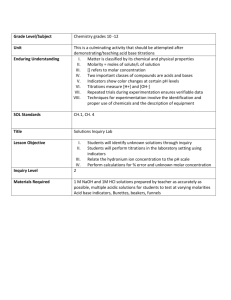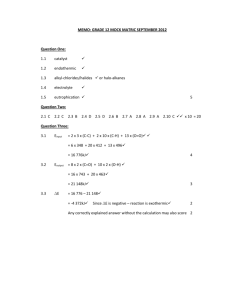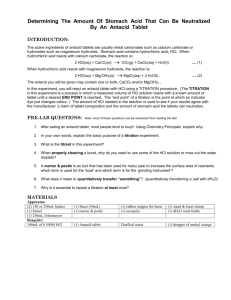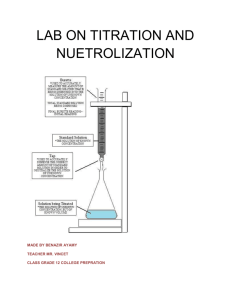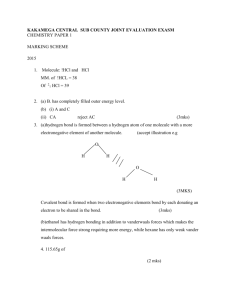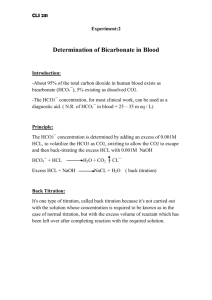Determining The Amount Of Stomach Acid That Can Be Neutralized
advertisement
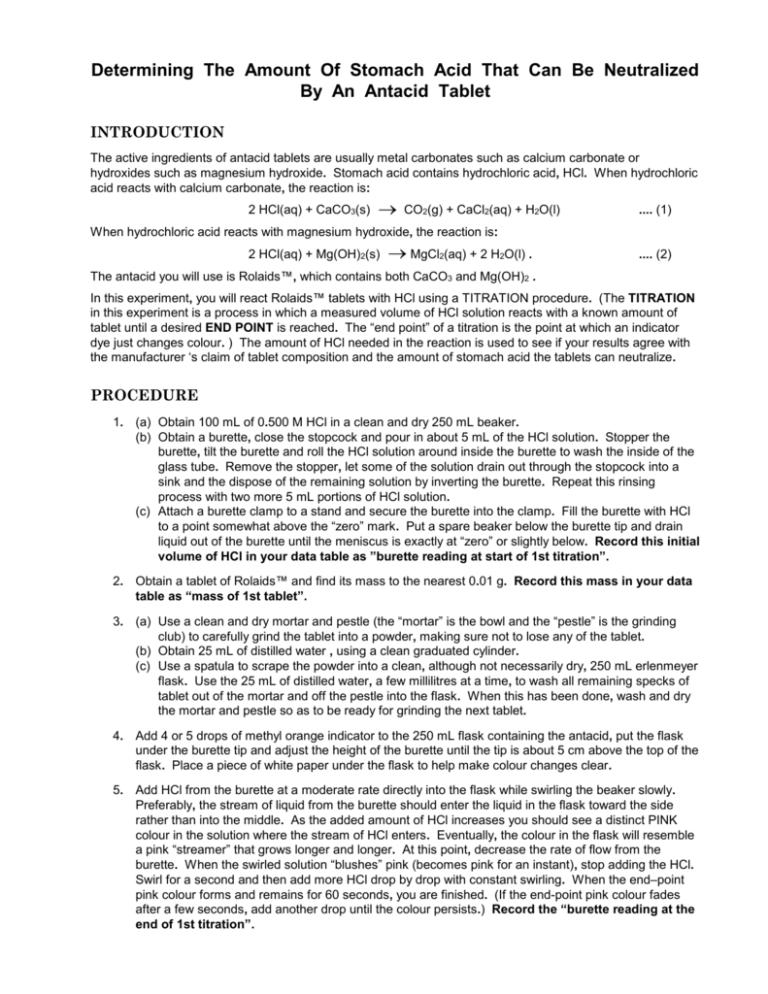
Determining The Amount Of Stomach Acid That Can Be Neutralized By An Antacid Tablet INTRODUCTION The active ingredients of antacid tablets are usually metal carbonates such as calcium carbonate or hydroxides such as magnesium hydroxide. Stomach acid contains hydrochloric acid, HCl. When hydrochloric acid reacts with calcium carbonate, the reaction is: 2 HCl(aq) + CaCO3(s) CO2(g) + CaCl2(aq) + H2O(l) .... (1) When hydrochloric acid reacts with magnesium hydroxide, the reaction is: 2 HCl(aq) + Mg(OH)2(s) MgCl2(aq) + 2 H2O(l) . .... (2) The antacid you will use is Rolaids™, which contains both CaCO3 and Mg(OH)2 . In this experiment, you will react Rolaids™ tablets with HCl using a TITRATION procedure. (The TITRATION in this experiment is a process in which a measured volume of HCl solution reacts with a known amount of tablet until a desired END POINT is reached. The “end point” of a titration is the point at which an indicator dye just changes colour. ) The amount of HCl needed in the reaction is used to see if your results agree with the manufacturer ‘s claim of tablet composition and the amount of stomach acid the tablets can neutralize. PROCEDURE 1. (a) Obtain 100 mL of 0.500 M HCl in a clean and dry 250 mL beaker. (b) Obtain a burette, close the stopcock and pour in about 5 mL of the HCl solution. Stopper the burette, tilt the burette and roll the HCl solution around inside the burette to wash the inside of the glass tube. Remove the stopper, let some of the solution drain out through the stopcock into a sink and the dispose of the remaining solution by inverting the burette. Repeat this rinsing process with two more 5 mL portions of HCl solution. (c) Attach a burette clamp to a stand and secure the burette into the clamp. Fill the burette with HCl to a point somewhat above the “zero” mark. Put a spare beaker below the burette tip and drain liquid out of the burette until the meniscus is exactly at “zero” or slightly below. Record this initial volume of HCl in your data table as ”burette reading at start of 1st titration”. 2. Obtain a tablet of Rolaids™ and find its mass to the nearest 0.01 g. Record this mass in your data table as “mass of 1st tablet”. 3. (a) Use a clean and dry mortar and pestle (the “mortar” is the bowl and the “pestle” is the grinding club) to carefully grind the tablet into a powder, making sure not to lose any of the tablet. (b) Obtain 25 mL of distilled water , using a clean graduated cylinder. (c) Use a spatula to scrape the powder into a clean, although not necessarily dry, 250 mL erlenmeyer flask. Use the 25 mL of distilled water, a few millilitres at a time, to wash all remaining specks of tablet out of the mortar and off the pestle into the flask. When this has been done, wash and dry the mortar and pestle so as to be ready for grinding the next tablet. 4. Add 4 or 5 drops of methyl orange indicator to the 250 mL flask containing the antacid, put the flask under the burette tip and adjust the height of the burette until the tip is about 5 cm above the top of the flask. Place a piece of white paper under the flask to help make colour changes clear. 5. Add HCl from the burette at a moderate rate directly into the flask while swirling the beaker slowly. Preferably, the stream of liquid from the burette should enter the liquid in the flask toward the side rather than into the middle. As the added amount of HCl increases you should see a distinct PINK colour in the solution where the stream of HCl enters. Eventually, the colour in the flask will resemble a pink “streamer” that grows longer and longer. At this point, decrease the rate of flow from the burette. When the swirled solution “blushes” pink (becomes pink for an instant), stop adding the HCl. Swirl for a second and then add more HCl drop by drop with constant swirling. When the end–point pink colour forms and remains for 60 seconds, you are finished. (If the end-point pink colour fades after a few seconds, add another drop until the colour persists.) Record the “burette reading at the end of 1st titration”. Antacid Titration – 2 6. Re–load the burette with HCl solution and record the “burette reading at start of 2nd titration”. (The burette does not have to be rinsed out with HCl; it already has HCl in it and can simply have more HCl added.) 7. Rinse out the 250 mL flask (it doesn’t have to be dry) and repeat steps 2 to 5 a second time. 8. Re–load the burette with HCl solution and record the “burette reading at start of 3rd titration”. 9. Rinse out the 250 mL flask (it doesn’t have to be dry) and repeat steps 2 to 5 a third time. CALCULATIONS 1. Calculate the total volume of HCl added in each titration (it equals the difference between the starting and ending volumes). 2. Use the total volume of HCl for each titration and the molarity of the HCl (0.500 M) to calculate the total moles of HCl added in each of the three titrations. This is called the “experimental total moles of HCl” for each tablet. Average the values for the “experimental total moles of HCl” and call the result “average experimental total moles of HCl”. Note: If the values of “experimental total moles of HCl” for two of the tablets are very close to each other and the third value is quite a bit different from the other two, state that you are omitting the value that is too far from the others and average the remaining two. 3. The label on each package of Rolaids claims that each tablet contains 675 mg of CaCO3 and 135 mg of Mg(OH)2 . Use this information to calculate a) the moles of CaCO3 in each tablet, and b) the moles of Mg(OH)2 in each tablet. 4. Use equations (1) and (2) in the INTRODUCTION, and the results of Calculation 3, to calculate a) the moles of HCl that react with the moles of CaCO3 in a tablet, and b) the moles of HCl that react with the moles of Mg(OH)2 in a tablet, and c) the total moles of HCl that are expected to react with both the moles of CaCO3 and moles of Mg(OH)2 in each tablet. This is called the “expected total moles of HCl”. 5. Calculate the average percentage purity of the tablets from the following equation. percentage purity = average experimental total moles of HCl x 100% expected total moles of HCl 6. The CaCO3 and Mg(OH)2 referred to in Calculation 3 are called “active ingredients”. Calculate the total mass of the active ingredients in a tablet. Express the total mass of the active ingredients in “grams”. Using the “mass of 1st tablet” recorded in your Data Table, calculate the percentage of the 1st tablet’s mass that was “active ingredients”. Repeat the calculation for each of the other tablets and calculate the average of the percentages. As in Calculation 2, if the percentages for two of the tablets are very close to each other and the third value is quite a bit different from the other two, state that you are omitting the value that is too far from the others and average the remaining two. 7. a) Stomach acid has an average molarity of 0.010 M. Calculate the volume of stomach acid which contains the “experimental total moles of HCl”, using the average molarity of stomach acid. b) Stomach acid has a density of 1000 g/L. Calculate the mass of stomach acid, using the density of stomach acid and the volume of stomach acid calculated in 7(a). c) Some antacids claim they consume many times their own weight in stomach acid. Calculate the average mass of the antacid tablets you used. As in Calculation 6, if the masses of two of the tablets are very close to each other and the third value is quite a bit different from the other two, state that you are omitting the value that is too far from the others and average the remaining two. How many times larger than the average mass of the antacid tablets is the mass of stomach acid you calculated in 7(b)? Antacid Titration – 3 Data Table mass of 1st tablet = ___________ burette reading at the start of 1st titration = ___________ burette reading at the end of 1st titration = ___________ mass of 2nd tablet = ___________ burette reading at the start of 2nd titration = ___________ burette reading at the end of 2nd titration = ___________ mass of 3rd tablet = ___________ burette reading at the start of 3rd titration = ___________ burette reading at the end of 3rd titration = ___________



